从文体学视角解读公共演讲英语
- 格式:pdf
- 大小:64.77 KB
- 文档页数:5

以公开演讲为主题的一篇英语作文英文回答:Public speaking, the act of delivering a speech or presentation to an audience, can elicit a range of emotions, from excitement to trepidation. It is a skill that can be developed with practice and serves as a powerful tool for communication, education, and persuasion.One of the key benefits of public speaking is itsability to build confidence. By stepping outside of one's comfort zone and facing an audience, individuals candevelop a greater sense of self-assurance. The act of speaking in front of others requires preparation, organization, and the ability to think on one's feet. By successfully delivering a speech, individuals can gain a sense of accomplishment and increased self-esteem.Furthermore, public speaking enhances communication skills. It requires the ability to clearly and conciselyconvey information, ideas, and emotions to an audience. Speakers must be able to structure their thoughts, use effective language, and engage with their listeners. By practicing public speaking, individuals can improve their communication abilities in both personal and professional settings.Beyond its benefits for personal development, public speaking is a valuable tool for education and persuasion.It allows speakers to share knowledge, inform audiences,and inspire action. Through carefully crafted speeches and presentations, individuals can educate others on important topics, inspire them to make positive changes, and motivate them to take action.In conclusion, public speaking is a multifaceted skill that offers numerous benefits. It can build confidence, enhance communication skills, and serve as a powerful tool for education and persuasion. With practice and preparation, individuals can unlock the potential of public speaking and leverage its benefits to make a meaningful impact.中文回答:公共演讲。
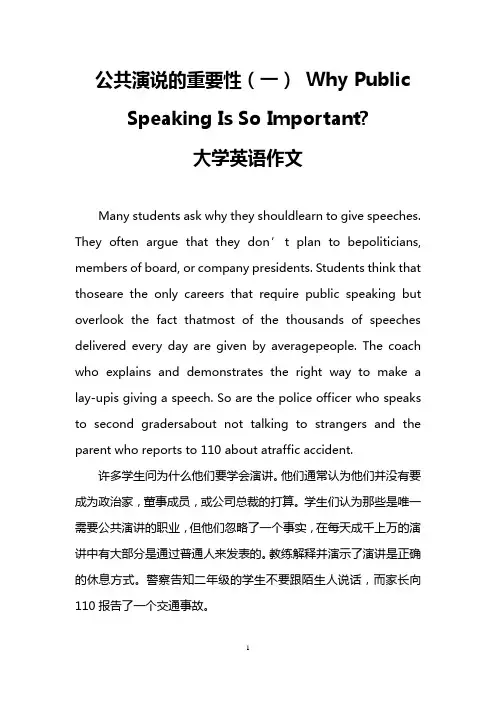
公共演说的重要性(一)Why Public Speaking Is So Important?大学英语作文Many students ask why they shouldlearn to give speeches. They often argue that they don’t plan to bepoliticians, members of board, or company presidents. Students think that thoseare the only careers that require public speaking but overlook the fact thatmost of the thousands of speeches delivered every day are given by averagepeople. The coach who explains and demonstrates the right way to make a lay-upis giving a speech. So are the police officer who speaks to second gradersabout not talking to strangers and the parent who reports to 110 about atraffic accident.许多学生问为什么他们要学会演讲。
他们通常认为他们并没有要成为政治家,董事成员,或公司总裁的打算。
学生们认为那些是唯一需要公共演讲的职业,但他们忽略了一个事实,在每天成千上万的演讲中有大部分是通过普通人来发表的。
教练解释并演示了演讲是正确的休息方式。
警察告知二年级的学生不要跟陌生人说话,而家长向110报告了一个交通事故。
If you think about it, you’vegiven and listened to more speeches than you realize. It only makes sense tostudy how to do it well, because speech-making is such an important part ofyour daily life. Most good speakers learn the speech-making skills; they weren’tborn with them. What is more, there are listening techniques that will help youget more out of the speeches you hear. You never know when you’ll have theopportunity to present a speech or to listen to one. By learning goodspeech-making techniques, you can take advantage of opportunities at school, onthe job and as a citizen in society.如果你想一想,你做和听到的演讲比你意识到的还要多。
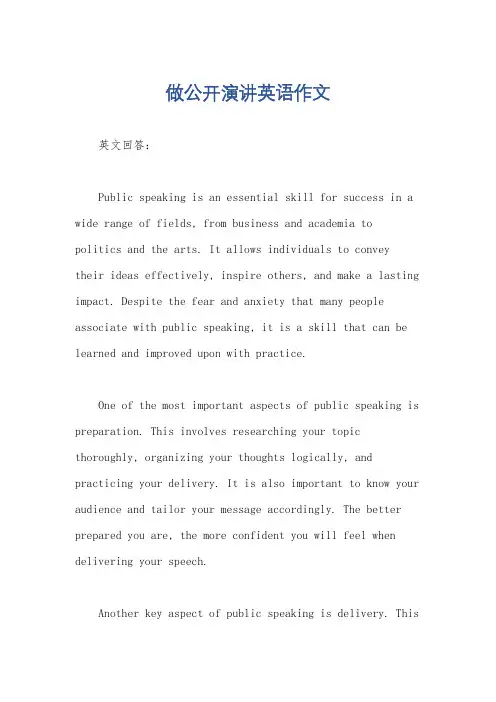
做公开演讲英语作文英文回答:Public speaking is an essential skill for success in a wide range of fields, from business and academia topolitics and the arts. It allows individuals to conveytheir ideas effectively, inspire others, and make a lasting impact. Despite the fear and anxiety that many people associate with public speaking, it is a skill that can be learned and improved upon with practice.One of the most important aspects of public speaking is preparation. This involves researching your topic thoroughly, organizing your thoughts logically, and practicing your delivery. It is also important to know your audience and tailor your message accordingly. The better prepared you are, the more confident you will feel when delivering your speech.Another key aspect of public speaking is delivery. Thisincludes your body language, tone of voice, and eye contact. Your body language should be open and inviting, while your tone of voice should be clear and engaging. It is important to maintain eye contact with your audience, as this helpsto create a connection and build rapport.Finally, it is important to be able to handle nervesand anxiety effectively. Many people experience some degree of nervousness before giving a speech, but it is importantto remember that this is normal. There are a number of techniques that can help you to manage your nerves, such as deep breathing, visualization, and positive self-talk.With preparation, practice, and a positive mindset, anyone can become a confident and effective public speaker. Public speaking is a valuable skill that can help you to achieve your goals and make a difference in the world.中文回答:什么是公开演讲。
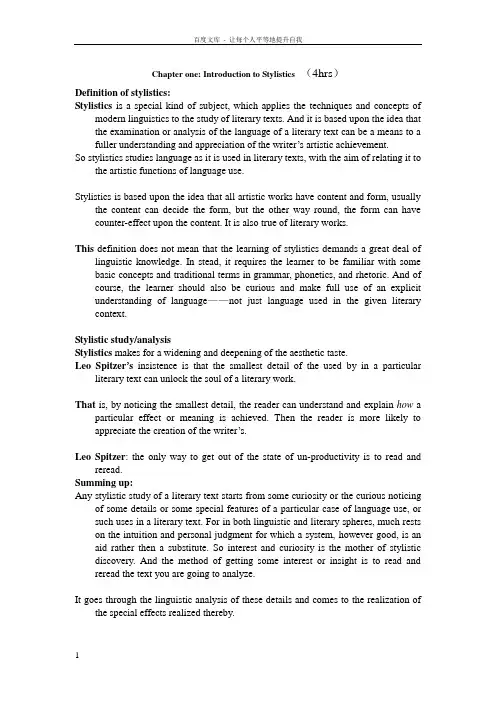
Chapter one: Introduction to Stylistics(4hrs)Definition of stylistics:Stylistics is a special kind of subject, which applies the techniques and concepts of modern linguistics to the study of literary texts. And it is based upon the idea that the examination or analysis of the language of a literary text can be a means to a fuller understanding and appreciation of the writer’s artistic achievement.So stylistics studies language as it is used in literary texts, with the aim of relating it to the artistic functions of language use.Stylistics is based upon the idea that all artistic works have content and form, usually the content can decide the form, but the other way round, the form can have counter-effect upon the content. It is also true of literary works.This definition does not mean that the learning of stylistics demands a great deal of linguistic knowledge. In stead, it requires the learner to be familiar with some basic concepts and traditional terms in grammar, phonetics, and rhetoric. And of course, the learner should also be curious and make full use of an explicit understanding of language——not just language used in the given literary context.Stylistic study/analysisStylistics makes for a widening and deepening of the aesthetic taste.Leo Spitzer’s insistence is that the smallest detail of the used by in a particular literary text can unlock the soul of a literary work.That is, by noticing the smallest detail, the reader can understand and explain how a particular effect or meaning is achieved. Then the reader is more likely to appreciate the creation of the writer’s.Leo Spitzer: the only way to get out of the state of un-productivity is to read and reread.Summing up:Any stylistic study of a literary text starts from some curiosity or the curious noticing of some details or some special features of a particular case of language use, or such uses in a literary text. For in both linguistic and literary spheres, much rests on the intuition and personal judgment for which a system, however good, is an aid rather then a substitute. So interest and curiosity is the mother of stylistic discovery. And the method of getting some interest or insight is to read and reread the text you are going to analyze.It goes through the linguistic analysis of these details and comes to the realization of the special effects realized thereby.The relation between stylistics and linguisticsLanguage plays the role of conceptualization and communication of meaning.1. Both st ylistics and linguistics are subjects that take language as their object ofstudy. They differ only in that the linguistics aims at the general and abstract aspects of language, ie. langue, while stylistics aims at the particular cases of language use, ie. speech/parole, together with special effect realized thereby.2. Stylistics is the application of linguistics to the study of literature.Stylists are interested in the details of the language used by certain writers in a certain text, and they look through these details to its significance.3. One of the major concerns of stylistics is to check or validate intuitions by detailedanalysis, but it is also a dialogue between a literary reader and a linguistic observer, and the goal of this dialogue is insight rather than objectivity.Linguistic analysis does not replace reader’s intuition, more importantly, it can prompt, direct, and shape it into an understanding.4. Stylistics builds on linguistics, and in return, it also challenges our linguisticframework, it always opens our eyes to the new horizons of our understanding of language and language use.The relation in between is a dialectical one.Different definitions of style:1. The most traditional definition of style is that style is a writer’s way/manner ofwriting or his mode of expression. This is a kind of dualist view about language based upon the belief that concerning language use there can be two aspects, namely, the content and the form. And some hold that style itself is part of the meaning or a component of the content of a form.2. Style as the dress of thought. This definition implies that style refers to the waysaying what one has to say.True wit is nature to advantage dressed,What oft was thought but n’er so well expressed.3. Style is manner of expression or manner of writing. So here in this definition,speech act is treated as the same as other common kinds of acts, the personal way of behaving forms the style of the person in question.4. Right word in the right place make a good style.Sum-up:1.Style is a way in which language is used, so it is related to parole rather thanlangue.2.Style consists in choices made from the repertoire of the language.3.Stylistic choice is limited to those aspects of linguistic choice which concernalternative ways of saying the same thing or of rendering the same subject matter.4. A style is defined in terms of a domain of language (what person said what inwhat place, what linguistic context, what manner, and for what purpose).5.Stylistics has been typically concerned with literary language.6.Literary stylistics is typically concerned with explaining the relation between styleand literary or aesthetic functions.StylisticsLecture Two: Introduction to Stylistics(continued)Leech defines stylistics as the study of the use of language in literature and considers it as the meeting ground of linguistics and the study of literature. So stylistics straddles two disciplines: linguistics and literary criticism.Stylistics is an interdisciplinary subject. It is a study of literary discourse from a linguistic orientation, that is, form a linguistic point of view. Therefore, it differs from linguistics and literary criticism in that it essentially links these two. In other words, it is an interdisciplinary subject.The start of this interdisciplinary subject:It is hard to determine when it became an academic field of study. But one thing is sure, that is, it did not achieve significant development as an independent subject until the late 1950’s. Now it has become a firmly established subject, which is supposed to provide useful insights into literary criticism and the teaching of literature.The basis on which stylistics has developed is English rhetoric, which can be traced back to Aristotle’s time.There have been three movements that promoted the development stylistics:1.Modernist movement in art and literature, which lasted from 1890 to World War II.This movement is characterized by its break away fro the tradition. This break away lifted all restraints upon the content and language used in art and literature.This led to the tolerance, acceptance, and appreciation of the different kinds of language that appear in literature and art.2.Another revolution occurred in the field of literary criticism, which had aprofound radical influence upon stylistics. The most important proponent of this revolution is I. A. Richards, who was dissatisfied with the criticism of his age for in his opinion the critics of his time had given too much attention to the moral aspect of literature, and he suggested that a more objective approach should be taken towards literary criticism. He based his approach upon close reading of the literary text and linguistic analysis of the language of the text.3.The third revolution that had helped the emergence of stylistics is the one thattook place in the science of linguistics in the late 1950’s. This revolution was initiated by the work of Noam Chomsky and Michael Halliday whose thoughts were directly or indirectly influenced by the linguistic theory of F. De Sassure.And generally speaking, the development in the domain of linguistics provided the stylisticians/stylists with effective and new tools for analyzing the language in use in both literature and other types of discourse.So the modernist movement aesthetically prepared the public or society for receiving and ushering in a new kind of literary criticism——stylistics.The neo-criticism directly enhanced the development of this new subject advocating objective analysis of the language of a literary text as the basis of literary criticism. The development of linguistics in the 1950’s supplied literary critics with the necessary and effective tools for investigating the language use in literary texts. So these three movements actually provided everything necessary for the appearance of this new subject.Two important assumptions of stylistics1.One important assumption of stylistics is that literature is made of language. It isan art of language. Now that literature is made of language, linguistics, which is the scientific study of language, is naturally helpful to us in analyzing and interpreting literary text.2.The second assumption is that literature is a type of communicative discourse.This assumption is just as important and basic as the first one. This assumption implies that, as Widdowson explicitly stated, a piece of language use, literary or otherwise, is invariably a piece of communication, a discourse of one kind or another. This assumption requires that one should understand the linguistic features of a literary text as occurring not randomly but rather with some meaning in it. These features are determined and also should be interpreted in reference to the context in which the communication occurs. This assumption extends the scope of the linguistic study of the language used in a literary text fro intra-sentential study to inter-sentential study.The first assumption justifies the necessity of the linguistic analysis of the literary text in the study of a literary work, while the second assumption puts the analysis of the language of the literary text in connection with context——both linguistic and social context.The goals, components, and procedure of stylistic inquiryGoalsThe first goal of stylistics is to help readers understand a literary text better. In other words, it provides insights into the meaning of the text.The second goal is to explain why and how one text is better than another one. That is to say that it is with interpretation that stylistics is more directly concerned.ComponentsDescription +interpretation +evaluationThe most important thing is to remember there is actually no rigid and fixed procedure of stylistic analysis of literary work. Linguistic observation and literary insight proceeds from each other and enhances each other and they form a cyclic motion.Procedure: Analytic phase +interpretative phaseThe nature of stylistic analysisGenerally, the stylistic analysis is mainly concerned with the uniqueness of the language use in a literary text. That is, to show what is peculiar to the language in a literary text. This is determined by the nature of style itself. This naturally involves comparison between the language used in the literary text under investigation and the language used in a conventional way.So essentially speaking, stylistic study is essentially comparative in nature.Lecture Two: Three Views of StyleWe have seen the definition of stylistics and some definitions of style.Next we will see some most influential and representative views of style.Text book p11Style as form. (Aristotle)(form and content )Style as eloquence.(Cicero)(skill to use L persuasively)(the relation with rhetoric)Style is the man. (Buffon)(L use is using it in discourse)Style as personal idiosyncrasy.(Murry)Saying the right thing in the most effective way.(Enkvist)Style as the choice between alternatve expressions. (Ibid)Style as equivalence. (Roman Jacobson)(between form and function)Style as foregrounding. (Leech Mukarovsky)Style as deviation.(Mukarovsky & Spitzer)Style as prominence.(Halliday)Style as the selections features partly determined by the demands of genre, form, themes, etc. (Traugott & Pratt)Style as linguistic features that communicate emotions and thought.(Enkvist)When writers write, they will naturaly try to make their language difffernt from the others’, so as to attract the attention of the readers and also to ensure and secure an independent existence. Or to stand out from the multitude of men of letters. Or just a special position for his writing. And that is to depart from the normal way of expression in a certain sense.Style as deviance.This view of stylistics comes from Widdowson’s remark of style holding that stylistic analysis has no fixed procedure and the technique of doing this kind of analysis is to pick on features in the text which appear to first impressions as unusual or striking in some way and then explore their ramifications. This remark implies that only those unusual or striking features are stylistically relevant. And the implied assumption is that the literary aesthetic effects can only be achieved through deviance. Though some stylisticians hold different views.It leads to such an assumption as that the distinctiveness of a literary text lies in its departure from the characteristics of what is communicatively normal. It also gives birth to the approach to style as deviance from the norms of a given language.Mukarovsky is another famous proponent and founder of this view of style. In his famous article Standard Language and Poetic Language, he speaks of style as foregrounding.He asserts that the violation of the norm of standard, especially, its systematic violation, is what makes possible the poetic utilization of language; without this possibility there would be no poetry. According to Mukarovsky normal use of language “automatizes”language to such an extent that the users no longer see its expressive or aesthetic power; poetry must de-automatize or foreground language by breaking the rules of everyday language. P13Such as the expression “a grief ago”“a presidency ago”“Mr. Smarter”“Mr. Bumble””The advantage of this approach to style is that it helps us keep in mind the there is a difference between everyday language and the language of literature.The disadvantages are that:a.It is difficult to define the norm from which the style of a text deviates.Bloch considers the basis of norm to e statistical, that is, to determinestyle by counting or resorting to the frequency distributions of linguisticfeatures as they differ from that of the language as a whole.b.It tends to lead the readers and stylisticians to value only the language ofthe grammatically highly deviant authors and under value those authorsthat do not deviate or do not deviate so much from the norms of language.And generally speaking, it tends to lead underestimation of thenon-deviant language both within literature and without.Style as choice.Style results from a tendency of speaker or writer to consistently choose certain structures over others available in the language.The difference between L and style is that L is the sum total of the structuresavailable to the speaker, while style concerns the characteristic choices by a certain writer either consistently or in a given text or context.To say that style is choice of words is not the same thing as saying that it is always a conscious choice, though of course if the writer always chooses his word scrutinously the effect of his way of using L will be all the more obvious as a style. Then that is pick his way forward among words, and it is hard to imagine how much literary work can there be by now. The stock of literature of we human kind no doubt will be greatly diminished. But most, almost all poets, and some writers, and all writers at certain points in their writing do write that way, that is, they a kind of choose scrutinously and seem to pick their way forward among the forest of words. . we Chinese posts have a tradition of refining words. 吟得一字安,捻断数茎须。
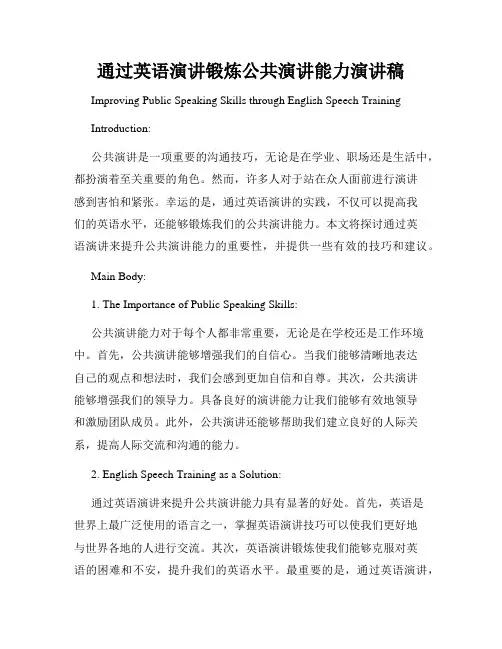
通过英语演讲锻炼公共演讲能力演讲稿Improving Public Speaking Skills through English Speech TrainingIntroduction:公共演讲是一项重要的沟通技巧,无论是在学业、职场还是生活中,都扮演着至关重要的角色。
然而,许多人对于站在众人面前进行演讲感到害怕和紧张。
幸运的是,通过英语演讲的实践,不仅可以提高我们的英语水平,还能够锻炼我们的公共演讲能力。
本文将探讨通过英语演讲来提升公共演讲能力的重要性,并提供一些有效的技巧和建议。
Main Body:1. The Importance of Public Speaking Skills:公共演讲能力对于每个人都非常重要,无论是在学校还是工作环境中。
首先,公共演讲能够增强我们的自信心。
当我们能够清晰地表达自己的观点和想法时,我们会感到更加自信和自尊。
其次,公共演讲能够增强我们的领导力。
具备良好的演讲能力让我们能够有效地领导和激励团队成员。
此外,公共演讲还能够帮助我们建立良好的人际关系,提高人际交流和沟通的能力。
2. English Speech Training as a Solution:通过英语演讲来提升公共演讲能力具有显著的好处。
首先,英语是世界上最广泛使用的语言之一,掌握英语演讲技巧可以使我们更好地与世界各地的人进行交流。
其次,英语演讲锻炼使我们能够克服对英语的困难和不安,提升我们的英语水平。
最重要的是,通过英语演讲,我们可以学习到不同的演讲技巧和方法,使我们的演讲更加生动、引人入胜。
3. Effective Techniques for English Speech Training:通过一些有效的技巧和方法,我们可以提高我们的英语演讲能力。
首先,我们需要选择一个合适的主题。
一个好的主题能够激发听众的兴趣,使演讲更具吸引力。
接下来,我们应该练习演讲的节奏和语调。
适当的节奏和语调可以使我们的演讲更有力和有感染力。
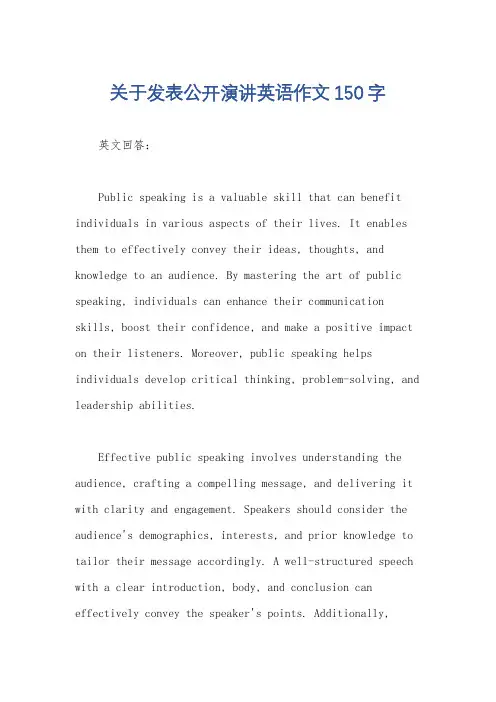
关于发表公开演讲英语作文150字英文回答:Public speaking is a valuable skill that can benefit individuals in various aspects of their lives. It enables them to effectively convey their ideas, thoughts, and knowledge to an audience. By mastering the art of public speaking, individuals can enhance their communication skills, boost their confidence, and make a positive impact on their listeners. Moreover, public speaking helps individuals develop critical thinking, problem-solving, and leadership abilities.Effective public speaking involves understanding the audience, crafting a compelling message, and delivering it with clarity and engagement. Speakers should consider the audience's demographics, interests, and prior knowledge to tailor their message accordingly. A well-structured speech with a clear introduction, body, and conclusion can effectively convey the speaker's points. Additionally,utilizing non-verbal cues, such as eye contact, gestures, and tone of voice, can enhance the delivery and connect with the audience on an emotional level.Practice is crucial in becoming an effective public speaker. Rehearsing the speech multiple times allows speakers to refine their message, improve their delivery, and build confidence. Seeking feedback from peers or mentors can provide valuable insights and help identify areas for improvement. By embracing opportunities to speak in different settings, individuals can gain experience and develop their public speaking abilities over time.中文回答:公开演讲是一项有价值的技能,它可以让个人在生活的各个方面受益匪浅。
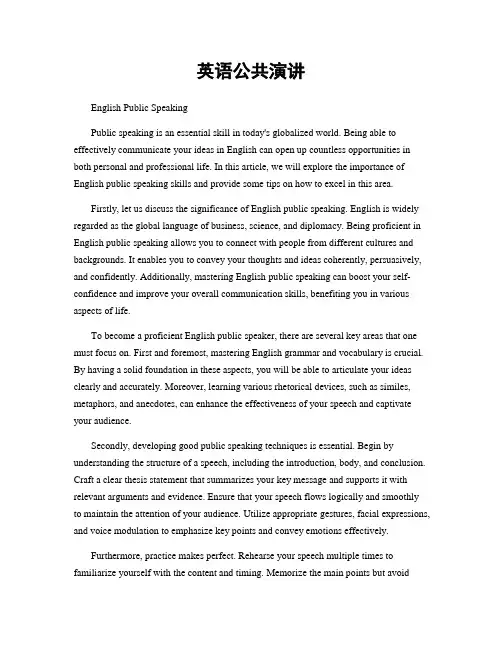
英语公共演讲English Public SpeakingPublic speaking is an essential skill in today's globalized world. Being able to effectively communicate your ideas in English can open up countless opportunities in both personal and professional life. In this article, we will explore the importance of English public speaking skills and provide some tips on how to excel in this area.Firstly, let us discuss the significance of English public speaking. English is widely regarded as the global language of business, science, and diplomacy. Being proficient in English public speaking allows you to connect with people from different cultures and backgrounds. It enables you to convey your thoughts and ideas coherently, persuasively, and confidently. Additionally, mastering English public speaking can boost your self-confidence and improve your overall communication skills, benefiting you in various aspects of life.To become a proficient English public speaker, there are several key areas that one must focus on. First and foremost, mastering English grammar and vocabulary is crucial. By having a solid foundation in these aspects, you will be able to articulate your ideas clearly and accurately. Moreover, learning various rhetorical devices, such as similes, metaphors, and anecdotes, can enhance the effectiveness of your speech and captivate your audience.Secondly, developing good public speaking techniques is essential. Begin by understanding the structure of a speech, including the introduction, body, and conclusion. Craft a clear thesis statement that summarizes your key message and supports it with relevant arguments and evidence. Ensure that your speech flows logically and smoothlyto maintain the attention of your audience. Utilize appropriate gestures, facial expressions, and voice modulation to emphasize key points and convey emotions effectively.Furthermore, practice makes perfect. Rehearse your speech multiple times to familiarize yourself with the content and timing. Memorize the main points but avoidsounding mechanical or robotic. Instead, aim for a natural and conversational delivery. Practice in front of a mirror or record yourself to identify areas for improvement. Additionally, consider joining a public speaking club or participating in competitions to gain experience and receive constructive feedback.In addition to technical skills, developing strong interpersonal skills is crucial in English public speaking. Engage with your audience by making eye contact and creating a friendly atmosphere. Consider their cultural background and adapt your language and content accordingly. Be open to questions, comments, and feedback, and respond graciously. Connecting with your audience on an emotional level can greatly enhance the impact of your speech and leave a lasting impression.Lastly, continuous learning and improvement are essential. Stay updated on current affairs, global trends, and relevant topics to ensure that your speeches remain insightful and relevant. Seek feedback from mentors, friends, or colleagues to identify areas for growth and work on them. Attend workshops or seminars on public speaking and learn from successful speakers. Embrace opportunities to speak in public and step out of your comfort zone.In conclusion, English public speaking is a vital skill for individuals who aspire to excel in an interconnected world. By mastering this skill, you can effectively communicate across cultures, enhance your overall communication skills, and boost your confidence. Focus on mastering English grammar and vocabulary, refine public speaking techniques, practice diligently, develop interpersonal skills, and embrace continuous improvement. Remember, the journey to becoming an excellent English public speaker may be challenging, but the rewards far outweigh the effort.。
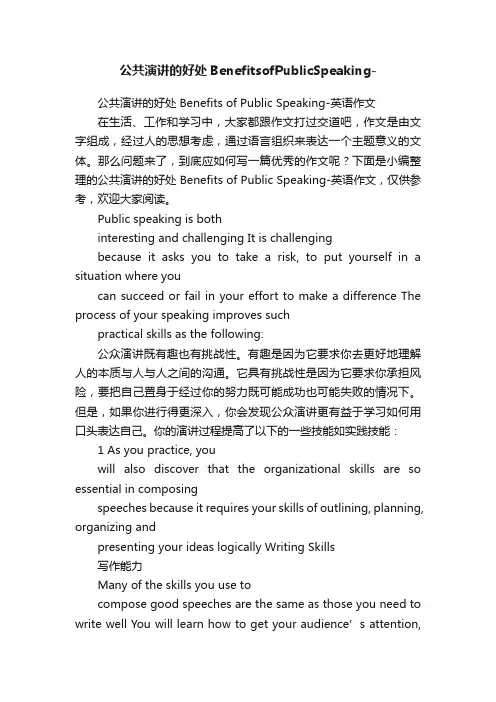
公共演讲的好处BenefitsofPublicSpeaking-公共演讲的好处 Benefits of Public Speaking-英语作文在生活、工作和学习中,大家都跟作文打过交道吧,作文是由文字组成,经过人的思想考虑,通过语言组织来表达一个主题意义的文体。
那么问题来了,到底应如何写一篇优秀的作文呢?下面是小编整理的公共演讲的好处 Benefits of Public Speaking-英语作文,仅供参考,欢迎大家阅读。
Public speaking is bothinteresting and challenging It is challengingbecause it asks you to take a risk, to put yourself in a situation where youcan succeed or fail in your effort to make a difference The process of your speaking improves suchpractical skills as the following:公众演讲既有趣也有挑战性。
有趣是因为它要求你去更好地理解人的本质与人与人之间的沟通。
它具有挑战性是因为它要求你承担风险,要把自己置身于经过你的努力既可能成功也可能失败的情况下。
但是,如果你进行得更深入,你会发现公众演讲更有益于学习如何用口头表达自己。
你的演讲过程提高了以下的一些技能如实践技能:1 As you practice, youwill also discover that the organizational skills are so essential in composingspeeches because it requires your skills of outlining, planning, organizing andpresenting your ideas logically Writing Skills写作能力Many of the skills you use tocompose good speeches are the same as those you need to write well You will learn how to get your audience’s attention,how toorganize your ideas clearly, and how to find more evidences to support your ideas许多用于撰写演讲的技巧和写好作文的技巧是一样的。
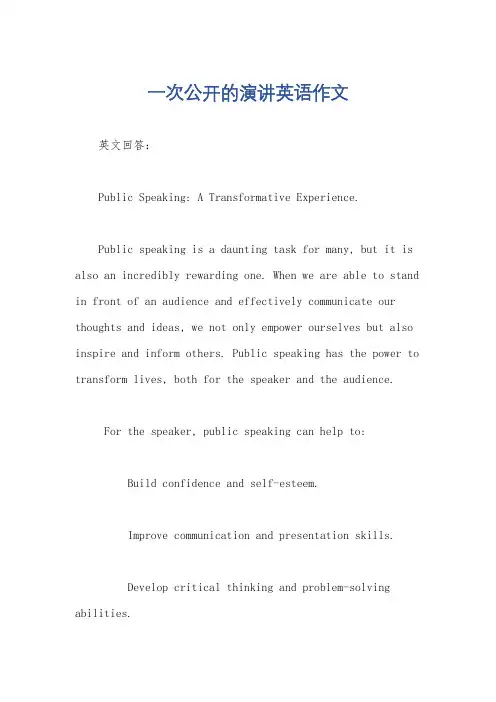
一次公开的演讲英语作文英文回答:Public Speaking: A Transformative Experience.Public speaking is a daunting task for many, but it is also an incredibly rewarding one. When we are able to stand in front of an audience and effectively communicate our thoughts and ideas, we not only empower ourselves but also inspire and inform others. Public speaking has the power to transform lives, both for the speaker and the audience.For the speaker, public speaking can help to:Build confidence and self-esteem.Improve communication and presentation skills.Develop critical thinking and problem-solving abilities.Expand knowledge and expertise.Enhance leadership qualities.Create a sense of accomplishment and purpose.For the audience, public speaking can:Provide information and education.Inspire and motivate.Persuade and influence.Build community and understanding.Spark critical thinking and discussion.The benefits of public speaking are undeniable. However, it is not without its challenges. Overcoming the fear of public speaking can be a significant obstacle for manypeople. But with practice, dedication, and the right mindset, anyone can become an effective public speaker.Here are some tips for overcoming the fear of public speaking:Prepare thoroughly. Know your topic inside and out. The more prepared you are, the less nervous you will be.Practice, practice, practice. The more you practice, the more confident you will become.Focus on your audience. Connect with your audience and make eye contact. Remember that they are there because they want to hear what you have to say.Don't be afraid to make mistakes. Everyone makes mistakes. The important thing is to learn from them and move on.Be yourself. Don't try to be someone you're not. The audience will appreciate your authenticity.Public speaking is a skill that can be learned and developed. With the right approach, anyone can become an effective public speaker and reap the many benefits that come with it.中文回答:演讲,一场蜕变之旅。

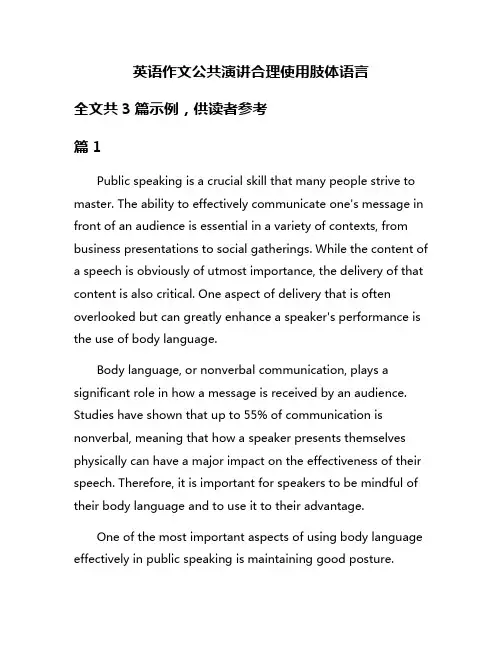
英语作文公共演讲合理使用肢体语言全文共3篇示例,供读者参考篇1Public speaking is a crucial skill that many people strive to master. The ability to effectively communicate one's message in front of an audience is essential in a variety of contexts, from business presentations to social gatherings. While the content of a speech is obviously of utmost importance, the delivery of that content is also critical. One aspect of delivery that is often overlooked but can greatly enhance a speaker's performance is the use of body language.Body language, or nonverbal communication, plays a significant role in how a message is received by an audience. Studies have shown that up to 55% of communication is nonverbal, meaning that how a speaker presents themselves physically can have a major impact on the effectiveness of their speech. Therefore, it is important for speakers to be mindful of their body language and to use it to their advantage.One of the most important aspects of using body language effectively in public speaking is maintaining good posture.Standing up straight with shoulders back conveys confidence and authority, whereas slouching or hunching over can make a speaker appear insecure or unprofessional. Additionally, making eye contact with the audience and using hand gestures to emphasize key points can help to engage listeners and keep them interested in the speech.Another important aspect of using body language in public speaking is facial expressions. Smiling can help to create a positive rapport with the audience and convey warmth and approachability. On the other hand, frowning or scowling can create a negative impression and make listeners less receptive to the speaker's message. Therefore, it is important for speakers to be aware of their facial expressions and to use them to enhance their delivery.In addition to posture and facial expressions, movement can also play a role in effective public speaking. Walking around the stage or moving throughout the audience can help to command attention and keep listeners engaged. However, it is important for speakers to strike a balance and not to move too much, as excessive movement can be distracting and detract from the message.Overall, the use of body language in public speaking is a powerful tool that can greatly enhance the effectiveness of a speech. By maintaining good posture, using facial expressions, and incorporating movement into their delivery, speakers can create a strong connection with their audience and make their message more compelling and persuasive. Therefore, it is important for anyone looking to improve their public speaking skills to pay attention to their body language and to practice using it effectively. So, let's strive together to master this skill and become more effective and engaging speakers.篇2Public speaking is an essential skill that can greatly benefit individuals in various aspects of their lives, such as career advancement, networking, and personal growth. While mastering the content of a speech is crucial, the use of body language can also significantly enhance the effectiveness of a presentation. In this essay, we will explore the importance of utilizing body language in public speaking and discuss some tips for using it effectively.First and foremost, body language plays a vital role in communication. Studies have shown that nonverbal cues, such as facial expressions, gestures, and posture, can convey moremeaning than words alone. By incorporating appropriate body language into a speech, a speaker can engage the audience, emphasize key points, and establish a connection with listeners. For example, maintaining eye contact with the audience can demonstrate confidence and credibility, while using hand gestures can help to illustrate concepts and keep the audience’s attention.Furthermore, body language can help to convey emotions and create a more dynamic and engaging presentation. By using facial expressions and gestures, a speaker can express enthusiasm, convey passion, and evoke emotions in the audience. This can make the speech more memorable and impactful, as listeners are more likely to be moved by a speaker who displays genuine emotion and conviction.In addition, body language can help to reinforce the message of a speech and make it more persuasive. Research has shown that body language can influence how a message is perceived by the audience. By aligning one’s verbal and nonverbal communication, a speaker can enhance the clarity and impact of their message. For example, using open and confident body language can help to establish trust and credibility, while using mirroring techniques can create rapport with the audience.To use body language effectively in public speaking, it is important to be mindful of your gestures, facial expressions, and posture. Here are some tips for incorporating body language into your speeches:1. Maintain good posture: Stand tall, with your shoulders back and your head held high. This will convey confidence and authority to the audience.2. Make eye contact: Look directly at the audience members and make eye contact with individuals throughout your speech. This will help to establish a connection and keep the audience engaged.3. Use hand gestures: Use natural and purposeful hand gestures to emphasize key points and add visual interest to your speech. Avoid excessive or distracting movements.4. Smile and use facial expressions: Smile genuinely and use facial expressions to convey emotions and engage the audience. Expressiveness can help to make your speech more engaging and relatable.5. Be mindful of your body language: Pay attention to your body language and make adjustments as needed to convey theappropriate tone and message. Practice in front of a mirror or record yourself to analyze your nonverbal cues.In conclusion, body language is a powerful tool that can enhance the effectiveness of public speaking. By using appropriate gestures, facial expressions, and posture, a speaker can engage the audience, convey emotions, and reinforce the message of their speech. By incorporating body language into your presentations and practicing effective techniques, you can become a more confident and compelling speaker.篇3Title: The Importance of Using Body Language Effectively in Public SpeakingIntroductionPublic speaking is a powerful tool that can enhance one's ability to communicate effectively with others. It allows individuals to share their ideas, thoughts, and perspectives on various topics. One key aspect of successful public speaking is the use of body language, as it can greatly enhance the message being delivered and ensure that the audience remains engaged throughout the presentation.Body Language and CommunicationBody language, also known as nonverbal communication, plays a significant role in how a message is perceived by the audience. It includes gestures, facial expressions, posture, and eye contact, among other nonverbal cues. Research has shown that body language can account for more than 50% of a speaker's message, making it a crucial factor in successful communication.Effective Use of Body LanguageTo ensure that body language enhances rather than distracts from the message being delivered, speakers should be mindful of the following tips:1. Use gestures to emphasize key points: Gestures can help to underscore important points and make the message more memorable to the audience. However, gestures should be natural and not overdone, as excessive movements can be distracting.2. Maintain eye contact: Eye contact is a powerful form of nonverbal communication that signals confidence and engagement. By making eye contact with the audience, speakers can establish a connection and convey sincerity.3. Pay attention to posture: Good posture conveys confidence and professionalism. Speakers should stand tall, with shoulders back and head held high, to project a sense of authority and credibility.4. Smile and use facial expressions: Smiling and using facial expressions can help to create a positive atmosphere and engage the audience. Expressive facial gestures can also convey emotions and add depth to the message being delivered.5. Use movement purposefully: Moving around the stage can help to keep the audience's attention and add energy to the presentation. However, movement should be purposeful and coordinated with the content being delivered.The Impact of Body Language on Public SpeakingEffective use of body language can greatly enhance the impact of a public speech. It can help to establish rapport with the audience, create a connection, and convey confidence and authority. Additionally, body language can help to reinforce key points, clarify complex ideas, and engage the audience on a deeper level.ConclusionIn conclusion, body language is a powerful tool that can greatly enhance the effectiveness of public speaking. By using gestures, maintaining eye contact, paying attention to posture, and using facial expressions purposefully, speakers can ensure that their message is communicated clearly and effectively. Ultimately, mastering the art of body language can help speakers to connect with their audience, build credibility, and deliver impactful presentations.。
什么是公共英语演讲稿公共英语演讲稿。
公共英语演讲稿是指在公共场合,以英语为主要语言进行演讲的文稿。
在现代社会,英语已经成为一种全球性的语言,具有广泛的使用范围和重要的国际交流地位。
因此,掌握一定的英语演讲能力对于个人的发展和国际交流至关重要。
在这篇文档中,我们将探讨什么是公共英语演讲稿,以及如何写好一篇公共英语演讲稿。
首先,公共英语演讲稿需要具备一定的结构和内容。
一个成功的演讲稿应该包括以下几个部分,开场白、正文、结尾致辞。
开场白需要引起听众的兴趣,可以通过一个引人入胜的故事、一个令人深思的问题或者一个引人注目的统计数据来引起听众的注意。
正文部分是演讲的核心,需要围绕主题展开,逻辑清晰,重点突出。
结尾致辞需要简洁明了,可以通过总结全文、呼吁行动或者留下深刻的印象来结束演讲。
其次,写好一篇公共英语演讲稿需要注意语言的选择和运用。
在演讲中,语言是沟通的桥梁,因此需要选择准确、生动、简洁的语言来表达自己的观点和情感。
避免使用过于复杂的词汇和句式,以免让听众产生困惑。
同时,要注意语气的把握,根据不同的主题和场合选择合适的语气,让听众产生共鸣。
最后,一篇成功的公共英语演讲稿需要具备一定的表达技巧和情感投入。
在演讲中,表达技巧是至关重要的,可以通过声音的抑扬顿挫、肢体语言的配合、眼神的交流等方式来增强演讲的效果。
同时,情感投入也是必不可少的,演讲者需要真诚地表达自己的情感,让听众感受到演讲的真诚和热情。
总之,公共英语演讲稿是一种重要的书面表达形式,它可以帮助演讲者更好地表达自己的观点和情感,增强演讲的说服力和感染力。
因此,我们需要认真对待公共英语演讲稿的写作,不断提高自己的表达能力和演讲技巧,以便在各种场合都能够自如地进行英语演讲。
希望通过本文的介绍,能够帮助大家更好地理解和写好公共英语演讲稿。
摘要随着社会的发展,世界范围内竞争的加剧,社会对人才的选择标准也日趋综合化。
演讲能力就是对这种新型人才的一项起码的素质要求。
我国领导人,包括温家宝总理最近出访美国等国,常常会在国外发表一些重要演讲:外国总统候选人竞选的一个重要途径就是通过演讲宣传自己的政治主张,让国民了解自己,以求得民众支持。
进入1】|『T0,我国在许多方面都要与国际接轨,对英文演讲能力的要求,肯定很快会在未来的各个行业,各个领域成为不成文的规定。
特别是英语政治演讲,由于其在国内国际事务中举足轻重的地位,使我们不得不慎重分析研究。
一篇成功的演讲主要包括两大因素:实质性的内容和非常得体很有特点的表达手段。
本文作者从英语政治演讲的功能出发,对促成该种功能实现最大化的文体张力因素进行有益的探索性研究。
该探索主要立足于杰出的系统功能文体学派代表人Halliday所提出的语言三大元功能(概念的,人际的,语篇的)理论,结合许多其他著名文体学家文体理论的精华(如Buffon的作家决定论,Riffa.terre的读者反应论,StanleyFish的感受文体学),借助Jakobson的文体分析多维思路,提出功能文体分析的多维理论,并且推崇功能决定文体的理念,试图从功能出发对演讲进行文体分析。
Jakobson是将诗歌语言的研究同具有强大生命力的语言学分析模式相结合的第一人,暗示文体分析应兼顾作者,文本,读者及语境等多种相关因素。
以往所有的文体分析都是从形式去说明功能内容,本文中的论点与其相反,是从功能目的出发考察实现这一功能最大化的文体手段,指出功能文体分析应从政治演讲的每项功能出发,进行多角度的实现这一功能的文体因素分析,这也是一种思维方式的创新与探索,因此本文的方法论意义胜过其学术理论意义.本文着重从文体的定义,本质和表现因素,以及演讲特别是政治演讲的功能特点出发,寻求二者的接合点,政治演讲的突出功能为告知,感化,说服,鼓动听众。
告知是每篇演讲的论题核心,属于概念功能,本文从众多国外政治演讲名篇中选出几例,研究实现这一功能的几种有效的文体手段。
在公共场合演讲英语作文Public Speaking in English.Public speaking is an essential skill that can open doors to numerous opportunities and help individuals achieve their goals. However, it is also a skill that many people fear, as it requires confidence, clarity, and the ability to engage an audience. In this article, we will explore the ins and outs of public speaking in English, providing tips and strategies to help you overcome your fears and become an effective speaker.First and foremost, it is important to understand that public speaking is not just about talking. It is about engaging your audience, delivering a clear message, and creating a connection with your listeners. Therefore, it is crucial to prepare well before stepping onto the stage.One of the most important steps in preparing for a public speech is research. Identify your topic and gatherrelevant information and examples that will support your points. Research will help you build a strong foundationfor your speech and ensure that you have something valuable to share with your audience.Once you have your topic and research in place, it is time to structure your speech. Begin by outlining your main points and organizing them in a logical order. Then, create an introduction that captivates your audience's attention and sets the tone for your speech. End with a conclusion that summarizes your main points and leaves your listeners with a lasting impression.When it comes to delivering your speech, there are several key elements to consider. Firstly, speakconfidently and maintain eye contact with your audience. This will help establish trust and credibility. Secondly, use clear and concise language to communicate your message effectively. Avoid jargon or complex language that may confuse your listeners. Finally, vary your tone and pace to keep your audience engaged. Use examples, stories, and humor to illustrate your points and make your speech morememorable.In addition to these basic tips, there are several other strategies that can help you become a more effective public speaker. One such strategy is to practice your speech repeatedly. This will help you familiarize yourself with the content and feel more confident when presenting it to an audience. It is also important to seek feedback from others, as they may provide valuable insights and suggestions that can help improve your speech.Moreover, it is crucial to remember that public speaking is a skill that can be developed over time. Do not be discouraged if you feel nervous or awkward at first. With practice and experience, you will become more comfortable and confident in your ability to engage and inspire your audience.In conclusion, public speaking is an essential skill that can benefit individuals in various aspects of their lives. By preparing well, structuring your speech effectively, delivering it confidently, and seekingfeedback, you can overcome your fears and become an effective public speaker. Remember, practice makes perfect, so keep at it and never stop improving your skills!。
Dec. 2006, Volume 4, No.12 (Serial No.39) US-China Foreign Language, ISSN1539-8080, USA 42 从文体学视角解读公共演讲英语 李 美1,曹 金2 (1. 山东科技大学外国语学院,山东青岛 266510;2. 中国石油大学英语系,北京 102249)
摘 要:英国首相邱吉尔的“希特勒对苏联入侵的演讲”是公共演讲的典型代表,本文以其演讲为例,分析公共演讲英语的语言特点,并试图描绘出公共演讲英语的严肃性和生动性的文体特征。 关键词:公共演讲英语;文体特征;严肃性;生动性
1. 前 言 Wales把文体学定义为“对文体的研究”(Wales,1989),这一定义既清晰又简练。然而,Widdowson认为“所谓文体学,就是从语言学角度研究文学语篇”(Widdowson,1975,转引自王守元,2000)。随着现代语言学研究在西方的迅速发展,文体学研究也取得了巨大进步。在中国,一方面,传统文体学研究主要集中在诗歌研究方面,成为诗学研究一个分支;另一方面,当代文体学研究主要集中于研究语篇分析和篇章语言学的区别。在当代研究中,关于文体学的著作大量涌现,文体学在语篇分析和英语教学中也发挥着越来越大的作用。本文以邱吉尔的“希特勒对苏联入侵的演讲”为例,试图描绘出公共演讲英语的严肃性和生动性的特征。
2. 公共演讲英语的文体分析 2.1 词汇特征 与日常会话相比,公共演讲对于词语的选择更加严谨。“公共演讲英语中,在讨论概念、品质和属性时需要抽象词汇的使用,同时,抽象词和大词的使用与演讲英语要求具有严谨性和庄重性的特点相一致”(徐有志,1992:109)。这篇论文使用了大量合成词,例如indistinguishable,ferocious,threshold,immemorial,primordial,villainous,irrevocable,steadfastly,catastrophe,accomplished,subjugation,hemisphere等等。这些大词的使用不仅增加了理解的难度,而且使演讲的语言更加严肃、更具权威性,使听众感到演讲者在政治上是严肃的。这篇演讲的另一个特点就是第一人称代词的广泛运用。
表1 人称代词运用 人称代词 第一人称代词(单数)第一人称代词(复数)第二人称代词 第三人称代词 总计 33 20 1 38
通过使用第一人称代词(单数“我”),演讲者表明了自己的立场,而第一人称代词(复数“我们”)的使用把演讲者和听众联系起来,给听众以亲和力,因此更能获得来自听众的接受和支持。“我们”的连续运用暗示听众应该团结起来加入反法西斯统一战线,粉碎法西斯主义者独裁统治世界的野心。 2.2 句法特征
【作者简介】 李美(1980- ),女,山东科技大学外国语学院硕士研究生;研究方向:认知语言学与应用语言学。 曹金(1982- ),女,中国石油大学英语系硕士研究生;研究方向:认知语言学与英语教学。 从文体学视角解读公共演讲英语 43相对于日常用语和商业广告,公共演讲英语写作更加正式。在这篇演讲中,句子的容量和功能都得到了充分发展。我们将从以下四个方面进行分析:句子结构,动词短语,句子类型和名词短语。 2.2.1 句子结构 这篇演讲总共有68个句子,最长的句子是第十二段第六个句子,包含68个单词;最短的是第五段的句子,只有三个词。这篇演讲总共有1439个单词,平均一个句子的长度是21.6个单词,每句平均含词量超过了整个英语的平均含词量(17.6词/句)。从下面的统计可以看出,大多数句子的长度在3到19个单词之间,含词量在20到39个单词之间的句子,也占到了句子总数的30.9%。长句倾向于表达复杂句义,而且可以造成高雅和肃穆的艺术效果。
表2 句子长度 句子单词数量 句子数量 所占比例 3~19 41 60.3% 20~39 21 30.9% 40~59 5 7.3% 60~68 1 1.5%
在句子结构上,英语演讲与商业广告、日常会话和即兴演讲也有所不同,一个很显著的特点就是使用了大量的以副词开头的句子,在这篇演讲中,总共有12个以副词开头的句子。副词引导的状语句占了句子总数的16.6%,与其它文体相比,公共演讲英语中的状语部分更加复杂,例如在第十一段第三个句子,状语包含30个单词,而十二段第二个句子,状语包含26个单词。这种句式使听众不能很快接触到句子的主要内容,增加了悬念,这种句子在时间的使用上是不经济的,但却能吸引听众的注意力,强调句子的主体部分,与演讲者的条件和目的相一致。 2.2.2 动词短语 由于许多动词短语可以用名词和其它形式的短语代替,在公共演讲中动词短语相对简单,大多数动词都与情态词和助动词连用。演讲的时态也具有一定的复杂性。在这篇演讲中,一般现在时占主要地位,一共有51个,占49.5%,其它时态则不尽相同。这篇演讲重在回顾法西斯过去一段时间对欧洲甚至世界的侵略,呼吁英国全国民众现在应该加入反法西斯的行列,因而过去时和现在时较多,一般将来时和完成时是主要的辅助时态。受演讲题材的限制,这篇演讲主要是激起听众的热情,获得听众的支持,因而从语态上来看,主动语态占了92.2%,被动语态较少使用。
表3 句子时态 时态 一般现在时 一般将来时一般过去时现在完成时过去完成时 过去进行时总计 51 13 26 6 4 3
表4 句子语态 语态 主动语态 被动语态 总计 95 8
2.2.3 句子类型 公共演讲文体中,没有日常会话中的不完整句,也很少有广告或解说文体中的小句,所有的句子都是规范的完整句。由于演讲是事先准备好的讲话,而且全部时间都由演讲者支配,所以不会出现句中被人打断的现象。由于演讲需要准确的表达,同时语言要显得庄重可信,而小句起不到这种作用,加之演讲者有充裕的时间和许多其它强调演讲内容的语言手段,所以小句的出现显得不必要(王佐良、丁往道,1987)。在这篇演讲中,完整句的类型比较简单,几乎都是陈述句,有64个,占据句子总数的绝大部分,目的是从文体学视角解读公共演讲英语 44 促使语调平衡,给听众以庄重正式感。另一个特点就是祈使句的使用,这篇演讲使用了三个祈使句。祈使句需要听众的语言和行动反馈,因而祈使句的运用能增强句子劝说功能。非动词句在英语演讲中很少出现,它的使用仅仅是为了平衡语气。同时,演讲者也使用了两个省略句。省略句在英语演讲中使用频率也不高,因为在演讲者与听者之间的共同的已知信息很少,因此应避免使用省略句。在演讲中,疑问句也极少使用。因为疑问句虽然能使语言显得活泼,但使得演讲的庄重程度降低,使听众对演讲的严肃性缺乏信心。
表5 句子类型 句子类型 陈述句 排比句 祈使句 非动词句省略句 圆周句 疑问句 总计 64 8 3 1 2 2 1
2.2.4 名词短语 在演讲语言中,名词性短语看上去结构比较复杂,但主要是前指和后指居多。为了表达更加精确的信息,前指和后指的使用是十分必要的,而且这也不会在接听过程中给听众造成理解困难。对于听众来说,即使没有文本,由于指示词已经说出,把与其对应的修辞词、关系句以及其它修饰结构联系起来相对容易,这也与演讲英语正式的特点相吻合,可以使演讲致辞更加庄重。以第八自然段为例,它总共有12个句子,其中就有16个后指现象。最明显的一个就是第八句“For there are times when all pray-for the safety of their loved ones, the return of the bread-winner, of their champion, of their protector”。后指成分修饰不仅可以使语言更加庄重,内容更加严肃,而且能起到强调作用。 2.3 修辞方法 修辞手段的使用是演讲英语的另一个特点。为了得到听众的接受和支持,演讲者会使用一些修辞手段来增强演讲的说服力和号召力。修辞手段可以分为句法和语义两种,句法方面的主要修辞手段是排比和重复,在这篇演讲中,邱吉尔首相使用了8个排比结构: (1) We will never parley; we will never negotiate with Hitler or any of his gang (2) We shall fight him by land; we shall fight him by sea; we shall fight him in the air (3) Behind all this glare; Behind all this storm I see…. (4) I see the Russian soldiers standing…. I see them guarding…. I see the ten thousand villages…. I see advancing upon…. I see also the dull…. I see the German bombers…. I see that small group…. (5) That is our policy; and that is our declaration (6) We shall be fortified and encouraged in our efforts. We shall be strengthened and not weakened in determination and resources. (7) Let us learn the lessons already taught by such cruel experience. Let us redouble our exertions…. (8) The past, with its crimes, its follies, and its tragedies, flashes away. 在演讲语言中,比较突出的修辞手段就是排比结构(一组相似结构的单词、词组和句子对的排列)的使用,排比结构能够引起听众的注意,加深听众的印象,使演讲语言准确、严肃,更富有感染力。同时由于句式整齐,也增强了整体上的节律美。重复也是演讲者经常使用的一种修辞手段。“在短语或者句子的开始或结尾,一个单词或者一组单词的反复使用,能够造成一种强烈的情感共鸣的效果”(徐有志,1992)。例如: (1) From this nothing will turn us-nothing. (2) We have but one aim and one single, irrevocable purpose.